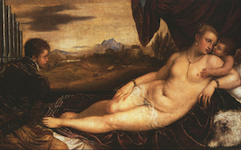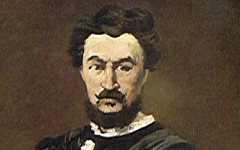Manet’s Self-Portrait with a Skull-Cap (1878-9)

Manet, Self-Portrait with a Skull-Cap (1878-9) Oil on canvas. Bridgestone Museum of Art, Tokyo.
Click image to enlarge.
This is a detail from one of Manet's only two self-portraits. It is important because it demonstrates how one artist identifies with another. Note, for instance, Manet's cap. It is similar to the cap that......
Click next thumbnail to continue
.....Filippino Lippi, the fifteenth-century Florentine artist, wears in his own self-portrait, a painting that Manet copied when he visited Italy in his early twenties. It is also similar to the cap that.....
Click next thumbnail to continue
......Titian wears in what would then have been his best-known self-portrait. By wearing the cap in his painting, whether or not the actual cap existed, Manet demonstrates his identification with the two earlier artists. Moreover, in placing the connecting symbol on his head, Manet states something more: "our minds are similar too."
See conclusion below
This sense of identification between one artist and another is so strong that even Larry Rivers, the twentieth-century American artist, could say in an address towards the end of his life: "....I was an artist in a drama about the history of art. I made the appropriate gestures; I played the role of connector from caveman artist up through the present. You name them, I was them.”1 It is a perennial, yet unrecognized, idea in art, sensed by masters in every century, regardless of style, period or country.
More Works by Manet
See what Manet recognized in Titian and how we can then learn it from Manet

Titian’s Venus (c.1548-9) and Manet’s Olympia (1863)
Notes:
1. Memorial Address, Hirshhorn Museum and Sculpture Garden, Sept. 16th, 1981, cited in Barbara Rose, “Larry Rivers: Painter of Modern Life” in Rose and Jacquelyn Days Serwer, Larry Rivers: Art and Artist (Washington, DC: Corcoran Gallery of Art) 2002, p. 47
Original Publication Date on EPPH: 04 Nov 2010. | Updated: 0. © Simon Abrahams. Articles on this site are the copyright of Simon Abrahams. To use copyrighted material in print or other media for purposes beyond 'fair use', you must obtain permission from the copyright owner. Websites may link to this page without permission (please do) but may not reproduce the material on their own site without crediting Simon Abrahams and EPPH.




